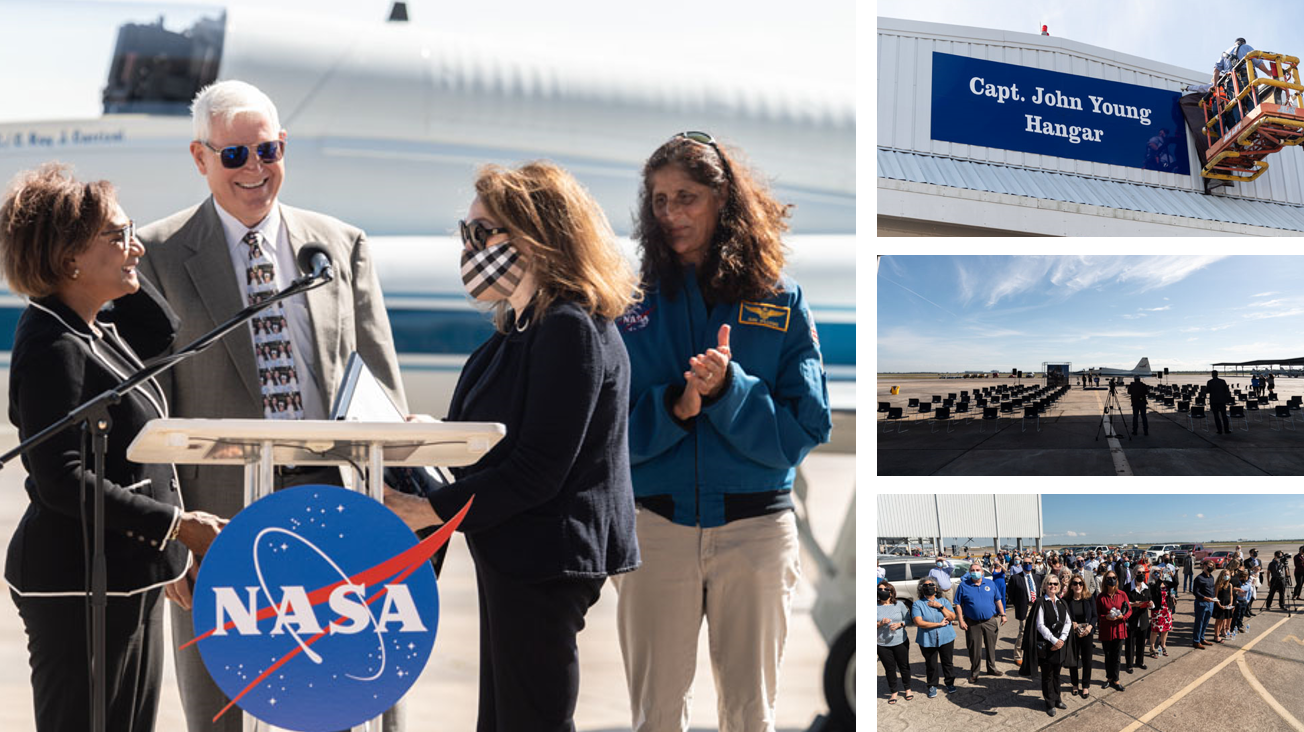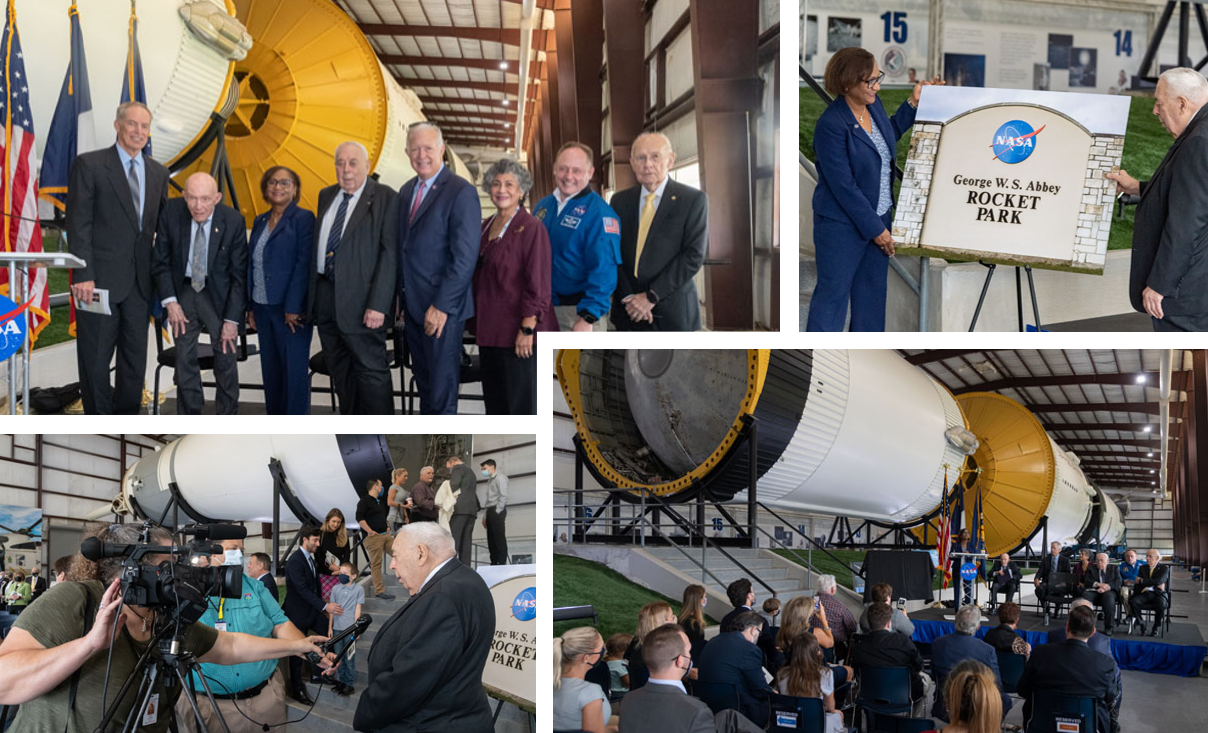Facility Dedications Honor NASA Stalwarts John Young and George W.S. Abbey
Recent facility dedications at NASA Johnson Space Center’s Ellington Field and Rocket Park honored astronaut Capt. John Young and former Johnson Director George W.S. Abbey, respectively.
Capt. John Young Hangar
On Oct. 19, NASA named a hangar at Ellington Field in Houston that holds NASA’s T-38 astronaut training jets after Young. Former astronaut and Johnson director Mike Coats joined Vanessa Wyche, current Johnson director, and NASA astronaut Suni Williams in making remarks for the dedication.
Young was considered a paragon of the astronaut corps, a pioneer who walked on the Moon during Apollo 16, commanded the first space shuttle mission, and continued to serve the agency as a champion of technical excellence and spaceflight safety. NASA astronauts regularly train for spaceflight in the T-38 jets housed in the Ellington Field hangar, so naming the facility for the accomplished pilot was considered fitting.
Young began his impressive career at NASA in 1962, when he was selected from among hundreds of young pilots to join NASA’s second astronaut class, known as the “New Nine.” He was the first person to launch into space six times from Earth (seven times counting his lunar liftoff).
His first flight was mission in 1965 with Gus Grissom on Gemini 3, the first Gemini mission with humans aboard. This was a complete end-to-end test of the Gemini spacecraft, during which Grissom accomplished the first manual change of altitude and orbital plane, and Young was the first person to operate a computer on a human-rated spacecraft.
In 1966, he commanded Gemini 10 and on his third flight in1969, Young was command module pilot of Apollo 10. Mission Commander Tom Stafford and Lunar Module Pilot Gene Cernan orbited the Moon, completed a lunar-orbit undocking and rendezvous with the lunar module, and tracked proposed lunar landing sites.
In 1972, Young walked on the Moon on his fourth spaceflight, Apollo 16, and served as mission commander with Command Module Pilot Ken Mattingly and Lunar Module Pilot Charlie Duke. Young and Duke set up scientific equipment and explored the lunar highlands at Descartes. They collected 200 pounds of rocks and drove over 16 miles in the lunar rover on three separate geology traverses.
In 1981, Young’s fifth flight was as spacecraft commander of STS-1, the first flight of the space shuttle, with Bob Crippen as pilot. The 54-and-a-half-hour, 36-orbit mission verified space shuttle systems performance during launch, on orbit, and entry. Space Shuttle Columbia was the first human spaceship tested during ascent, on orbit, and entry without the benefit of previous uncrewed missions. Columbia also was the first winged re-entry vehicle to return from space, weighing about 98 tons as Young landed it on the dry lakebed at Edwards Air Force Base, California.
In 1983, Young’s sixth flight was as commander of STS-9, the first Spacelab mission, from Nov. 28 to Dec. 8, 1983, with Pilot Brewster Shaw, Mission Specialists Bob Parker and Owen Garriott, and Payload Specialists Byron Lichtenberg of the U.S., and Ulf Merbold of West Germany. For 10 days, the six-person crew worked 12-hour shifts around the clock, performing more than 70 experiments in the fields of atmospheric physics, Earth observations, space plasma physics, astronomy and solar physics, materials processing, and life sciences.
For Young’s full biography, click here.

Credits: NASA/James Blair
Enjoy video from the event, below.
George W.S. Abbey Rocket Park
Then, on Dec. 10, Rocket Park at NASA’s Johnson Space Center in Houston was dedicated after Abbey, Johnson’s former director, in a ceremony. Home to one of only three Saturn V rockets on display in the world, the facility will now be known as George W.S. Abbey Rocket Park.
The Apollo rocket housed inside a protective building there is the only one comprised of all flight-certified hardware capable entering orbit around the Moon. The 36-story Saturn V was restored over the course of two years, from 2005 to 2007, and has been on loan to Johnson from the Smithsonian’s National Air and Space Museum collection since 1977. Outside, additional artifacts from the early human spaceflight program are on display.
Abbey, one of the most influential NASA leaders through the end of the 20th Century, distinguished himself throughout a career spanning five decades. In 1964, he was assigned to the Apollo program as an Air Force captain and, in 1967, became a NASA civil servant and technical assistant to Apollo Spacecraft Program Manager George M. Low. He participated in the Apollo 1 accident investigation and the development and implementation of spacecraft design changes that led to 13 successful Saturn V launches and six human Moon landings.
In 1970, Abbey and the Mission Operations Team earned the Presidential Medal of Freedom, the highest civilian honor in the United States, for their dedication and work to safely return the Apollo 13 crew home. Three years later, in recognition of his contributions to the Apollo Program, he received the NASA Distinguished Service Medal.
Abbey became director of Flight Operations at Johnson in 1976, where he led the operational planning and management of flight control and crew activities. In that role, he led the selection committee for the first group of space shuttle astronauts. More than 8,000 applied for the opportunity and, under Abbey’s leadership, the committee whittled the number of applicants to 35, known as the "Thirty-Five New Guys." For the first time, the new astronaut candidate class reflected the United States’ diversity, with six women and four minority candidates. Abbey’s guidance continued to prove invaluable during the early operational years of the Space Shuttle Program. From 1981-1986, the United States witnessed many firsts for the space program — the launch and safe return of the first reusable spacecraft, Space Shuttle Columbia, an American woman and an African American in space, and increasingly complicated satellite retrieval and repair missions.
Abbey moved to NASA Headquarters in 1988 to serve as the deputy associate administrator for spaceflight, and was later named both as the National Space Council’s senior director for civil space policy and special assistant to the NASA administrator. He played an important part in negotiating a partnership between NASA and the Russian Space Agency that led to an agreement to work together on what would become the Shuttle-Mir Program, also known as Phase I of the International Space Station (ISS) Program. Abbey was instrumental in restructuring the International Space Station after Space Station Freedom, and his efforts led to a vibrant ISS Program, which recently celebrated 20 continuous years of habitation.
After returning to Johnson in 1994 as deputy to the first female center director, Carolyn L. Huntoon, and Abbey became center director himself in January 1996. As director, he sought new ways to engage with the Houston community, reaching an agreement to open 53 acres of Johnson’s pastureland adjacent to Rocket Park to the Clear Creek Independent School District and Houston Livestock Show and Rodeo for a “hands-on” agricultural education facility known as the Longhorn Project. The facility offers students the opportunity to learn more about longhorns and agriculture.
Abbey led Johnson until February 2001 and ended his NASA career in January 2003.
George W.S. Abbey Rocket Park allows dreamers and spaceflight enthusiasts to stand beside history and is a place of wonder for visitors from all over the world through Space Center Houston, Johnson’s official visitor center.

Credits: NASA/James Blair
Enjoy video from the event, below.
Subscribe and get the latest NASA news with a weekly update in your inbox:







